I’ve long
wanted to visit Rio Azul Jungle Lodge, and the owners have been offering to
host me for an inspection visit for several years. I’ve just not had the free
time to follow up on it. But during the first planning stages of this current
private tour a year and a half ago, my clients did their research and asked if
I’d be willing to change my usual Mato Grosso itinerary a bit to add a few days
at Rio Azul. That didn’t take any convincing.
It’s only 39
kilometers (24 miles) from Cristalino Jungle Lodge the way the Bald Parrot
flies, but it’s amazing how different the habitats and resulting bird life is –
all reflecting a simple difference in geology. It takes nearly 3 1/2 hours of
travel to get there, starting with the boat ride from Cristalino Jungle Lodge to
the Teles Pires boat launch, where two taxis from Alta Floresta had been hired
by Rio Azul to meet us. From there we drove north to a ferry to cross back to
the east side of the Teles Pires.
From there
we drove in a zigzag fashion mostly northward through patches of forest and
many miles of cattle pasture (some of it the legacy of the former governor, now
in jail for corruption, as he used state-owned equipment to clear the land),
passing an active Jabiru nest, Burrowing Owls, and other birds that have
invaded the region in the past 30 years or so. Here are a couple Google Earth
screen captures that show the location relative to South America (southeastern
Amazonia, nearly in the center of the continent), and just NNW of Cristalino in
the state of Pará.
Rio Azul has
only seven cabins, and their idea is to stay small, hosting groups of either
birders or fishermen (but not both at the same time), and keep groups to about
eight people or fewer. The owners, Carlão and Ivani, have created a paradise
and continue to work here themselves, as guide, boatman, and chef. It was a wonderful
experience. The closed eyes and odd expressions in group photo here shows why one should always take multiple shots..
One main
attraction here is the Rio Azul river itself, a tributary of a tributary of the
Teles Pires (which itself is a tributary of a tributary of the Amazon). People can
fish here, but for the Komi family, a place to wade and swim was a draw (though
while the parents and I went birding on two days, the boys and the nanny went
fishing with Carlão).
One had to
watch for stingrays, and we did see a few. They’re not really dangerous as they
don’t bury themselves in order to ambush. You do have to watch where you walk,
but they are obvious and shy, swimming away before you can get very close as long as you’re not running through the water. The water here is unbelievably clear and
full of fish. The stingray diversity is surprisingly high (I think I heard
eight species) and hints at a very different geology millions of years ago when
there was a large inland sea connected at times to the ocean. The genus here is
Potamotrygon, which simply means
“river stingray” from ancient Greek (recall Hippopotamus, meaning "horse of the river," but then it makes me wonder about the quail-dove
genus Geotrygon, which must mean “ground
stingray”).
Two of the prize
birds that my clients hoped to see here are best seen by taking a boat ride on
the river, which we did our first morning. We passed the remains of a bridge that was demolished by the
Brazilian air force after the millions of square kilometers on the north bank of
the Rio Azul was declared a military reserve but only after settlers had already
built the bridge and started to clear the rainforest. So like Cristalino, Rio Azul
lodge is adjacent to one of the largest and best-protected continuous tracts of forest in the
southeastern Amazon.
The first of
the two targets was a fabulous hummingbird. Crimson Topaz is large, almost all
glittering red with a yellow throat, and possessing two elongated tail feathers
that cross and extend well beyond the other tail feathers. I don’t have my 50x
Canon PowerShot on this trip (in for cleaning and repairs), so this photo is
almost a joke. It does document my only lifebird of the trip as it was diving
down after grabbing an insect over the river – the two long tail feathers
point up, the bill points down.
The other
target bird, which we saw from the exact same spot in the river was a group of
seven Bald Parrots perched in a leafless tree by the river edge. Here’s a photo
of one I took at Cristalino Jungle Lodge in 2006, just four years after this
very strange species was first described to science (it was the first record
from there, where there are still only 3 or 4 records, straying from near here, no
doubt).
With the two
main specialties under our belt, we could relax and enjoy whatever new birds we
found – and there were plenty. We took three other boat rides, one in the early
morning before breakfast on a successful search for the elusive Zigzag Heron.
We had amazing views of it and raced back for breakfast. Here’s a video our
return on that trip to give an idea of what it’s like.
Surrounding
the lodge is some fine Amazonian rain forest (though we are here during the
winter/dry season and therefore no hint of rain). The early morning sun through
the canopy lit up this red-trunked tree beautifully. With the recent Scientific Reports article that lists 11,676 species of tree in the Amazon Basin, I will be lucky to eventually know no more than about 0.5% of them by the end of my lifetime.
Very common
in the taller forest was this vine, new to me. It is Heteropsis flexuosa, known as Titica (prounounced "chi-CHI-ca," and used widely for the
fibers in the aerial stem and roots. The family is Araceae, same as Philodendron and the familiar skunk
cabbage.
We had some
good birds in this taller forest, including at least three different Guianan
Gnatcatchers (or Para Gnatcatcher by some who split it), a very rare bird at Cristalino but much easier here.
Mixed flocks
had many of the same birds as at Cristalino (such as Chestnut-winged Hookbill
and Rufous-rumped Foliage-gleaner), but Rusty-breasted Nunlet seems more
regular here, as was Brown-banded Puffbird. This is one of two we saw and
several that we heard every day.
My friend
Brad Boyle identified this Voyria
spruceana for me. It’s in the family Gentianaceae and gets its nutrients
from underground fungi – though who knows if it gives anything in return or is
just a parasite.
Speaking of
fungi, though this is the dry season with not much around, I did find this
nicely dried out Lentinus crinitus,
identified using the downloadable fabulous new field guide by Jean Lodge and Susanne Sourell.
We saw several
of the really interesting birds here in a shorter forest as well as more open
scrub that grows on an isolated patch of very low nutrient white sand along the
entrance road – a feature that like the stingrays also harkens to an ancient
inland sea.
We had the
first local record of the widespread but patchily distributed Plain-crested
Elaenia, as well as a brief but good views of Blue-tailed Emerald. But I was
totally blown away when a pair of Rufous-crowned Elaenias popped up in response
to my recording and playback of an unknown vocalization, a quiet “grrrr” sound
from the scrub. A few hundred kilometers separate this occurrence from the
nearest other record, and I wasn’t even aware that the species occurred south
of the Amazon. I had seen it 17 years ago in the Gran Sabana of Venezuela and
then again just last year in the northern Brazilian state of Roraima. I got
recordings, which I appended to my eBird submission and can be heard on the
Macaulay Library’s website here.
The plants
in areas of white sand are fascinating. I especially took to the melastomes
here. This appears to be Sandemania
hoehnei, a real white sand specialist. The paper is Renner, Susanne S. 1987. Sandemania hoehnei (Melastomataceae; Tibouchineae): Taxonomy, Distribution, and Biology. Brittonia, Vol. 39, No. 4, pp. 441-446.
This is a Macairea sp., and though most of these
melastomes have very tough leaves, presumably for water retention, this one is
also unusual in having fewer than the normal number of primary veins running from
the base to the leaf tip.
But even
stranger is this Microlicia sp. with perfectly typical flowers but very tiny leaves folded down against the stem.
This
probable Remijia sp. in the family
Rubiaceae was notable in being stunningly fragrant, noticeable from at least 15
meters away.
I was
excited to see my first Mauritiella
armata, a palm with the local name of Buritirana. It’s is related to
Mauritia palms (famous among birders for the species that depend on it) but is much slenderer and with this notably armored trunk.
I recognized
these fruits as Euphorbiaceae (see the three stigmas), but it took a bit of
searching to find its name, Mabea angustifolia.
One of the
most prominent shrubs here is a yellow-flowered member of the family
Malpighiaceae, probably in the genus Byrsonima.
Rather than offering nectar to pollinators, it’s much like our SE Arizona Krameria in having oil instead. I found
the Brazilian bee expert Felipe Vivallo to identify this huge and stunningly
patterned bee as Centris (Ptilotopus) americana (with Doug Yanega pointing me in the right direction with the genus). The
name in parenthesis is a subgenus, useful in understanding insect taxonomy where
genera can have hundreds of species.
And this is Epicharis (Xanthepicharis) umbraculata,
also in the subfamily Centridinae and also collecting oil (as well as pollen,
visible on the legs). Dr. Vivallo may be using these photos in an upcoming
article on the biology of this subfamily.
Other
special birds that we saw in this white sand area were Green-tailed
Goldenthroat, Pale-bellied Mourner, and a pair of these Spotted Puffbirds.
Perhaps the
most unexpected and exciting find was a pair of Ocellated Crakes in the short
grass pasture just outside the gate of the property. The nearest record is
about 600 km away, and we found them only when I got the strange urge to play
the song, even though I didn’t have the slightest expectation there would be a
response, which was indeed almost instantaneous, and only 50 meters away. We
actually saw one bird when I shone my green laser pointer over the location where I saw the weeds move, in order to get Jarmo
and Inger to look in the right direction. That didn’t totally spook the birds, and
with further playback I saw a rufous face and red eye peek out of the dense
grass less than a meter away from my feet. But typical for the species they stuck
to the densest grass and didn’t cross any of the open areas. My recordings also
appear on the Macaulay Library website.
We saw a few
butterflies, many which I recognized from Cristalino. This is the swallowtail Battus belus, which amazingly was caught
by the quick and patient six-year-old Alex with his bare hands. Will he become a politician, actor, entrepreneur, or entomologist?
This
clear-winged beauty is Haetera piera,
Piera Satyr.
Metalmarks
are my favorite: the tiny Sarota gyas
with the furry legs…
…and Mesosemia philocles, sometimes called an
“eyemark.”
But even
skippers can be colorful, such as this Pythonides
jovianus, Variable Blue Skipper.
We saw very
few moths this time, not only because it has been very dry, but also during the
full moon porch lights tend to not attract as many insects. This sphingid is Callionima parce, Parce Hawkmoth.
This is a
silk moth, Therinia buckleyi, which
wasn’t at the lights at all but resting during the day on a leaf in the understory.
This one is
a day-flying metalmark-moth Hemerophila
sp., in the family Choreutidae.
I went out
at night three times, and during the first walk Jarmo and I found this Corallus hortulanus, Amazon Tree Boa. It
started striking blindly the moment it sensed my infrared signature from about
3 meters away, so I didn’t even try to pick it up (not that I haven’t been
bitten with little ill effect by several wild boas over the years); the traces
of DEET on my hands probably wouldn’t have done it much good anyway.
I took the
whole family including the kids on a short night walk to see if a tarantula was
out of her burrow, but we first stopped to marvel at a long and very busy trail
of this army ant Eciton sp. probably E. hamatus.
I actually
saw but was not able to photograph one of the parasitic silverfish, different
that the one I had seen with E. rapax inSE Peru last year.
The
tarantula was out, but not very far out of the burrow, and not for long, as
they have many possible predators and retreat at the slightest tremor. This is
probably in the genus Acanthoscurria,
but Google searches on tarantulas deliver so much noise it’s hard to get any
good identification information. Species limits are probably not very well
known here anyway, considering that only just this year was the common genus Aphonopelma sorted out for North
America.
On one short
night walk I took on my own, I came across this very small tarantula, with a
body only about 3 cm long.
Judging from
the eye arrangement, this is a wandering spider, family Ctenidae. Its rather
slender appearance had me thinking it was a wolf spider (Lycosidae) or a
prowling spider (Miturgidae), so it was good I got some shots of the eyes.
This appears
to be Micrathena cyanospina, an orb
weaver (Araneidae), though I did not detect any blue tint to the amazing, long
spines on the abdomen.
This is the
very widespread but always fascinating Araneid, Nephila clavipes, the Golden Silk Orb Weaver. The yellowish tint to
the silk here is real.
The way it
holds it legs, and then finally the eyes, convinced me this colorful thing was
a crab spider, family Thomisdae.
After our 10
days of Amazonian birding and natural history fun, we headed back to Alta
Floresta via the Teles Pires ferry for our flight back to Cuiabá. And then onward to the Pantanal.














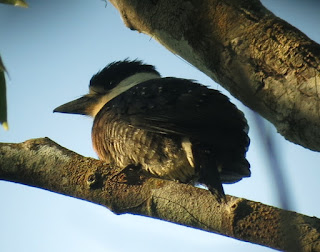






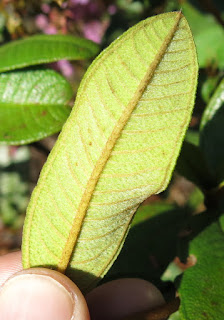








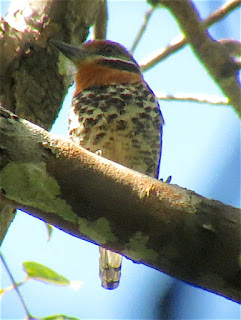
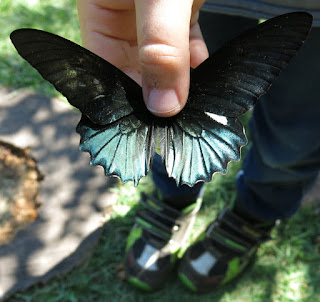

















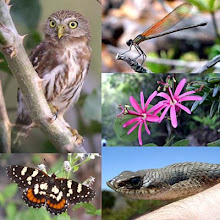




Beautiful record. Thanks.
ReplyDelete1) Why is a Bald Parrot bald? The head resembles a vulture. Is there any info as yet as to whether it feeds on cadavers or attacks live animals?
ReplyDelete2) Did you see any orchids, whether magnificent, average or minuscule? This is my 'thing'. Thanks.
Hi Rohan,
Delete1) Good question! I don't think anyone really knows. They mostly eat tree seeds and fruits like other parrots. I suspect that sexual and social selection for the physical appearance is more likely than any adaptation to the physical environment.
2) This being the middle of the dry season (and with the coolest temperatures of the year), there were few orchids in bloom during our stay. I did see two species in bloom at Cristalino Jungle Lodge just to the south:
Encyclia: https://flic.kr/p/KF9wrd
Cyrtopodium: https://flic.kr/p/JMA9fB
Thanks Richard. The reason I asked whether the Bald Parrot may eat meat was partly because I had a vague recollection (that I have now had a chance to check out) that the Kea Parrot of New Zealand has the reputation of attacking live sheep for its flesh/fat.
ReplyDeleteThanks for the info on orchids.
Greetings from Colombo, Sri Lanka.
Rohan
Hi Richard, very nice trip and great report.
ReplyDeleteIn this area I know only the Cristalino Lodge. This is very luxurious and high-priced. How are the prices in the Rio Azul?
Best greetings from Germany Steven.